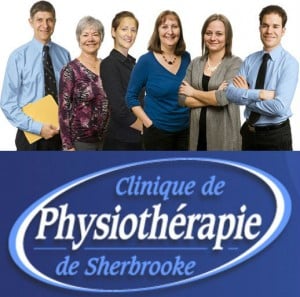This entry was written with the Clinique de Physiothérapie de Sherbrooke.
When a mother breastfeeds her baby, she can make mistakes. These can lead to repeated engorgements blocking the milk ducts that transport milk to the nipple. When this happens, the mother can have intense pain and the baby will be irritable because milk flows slower.
The duct is blocked by stagnated and coagulated (clotted) milk, blocking the path the milk takes to get to the nipple. The physical signs of a blocked duct are redness, swelling and pain in a part of the breast causing local engorgement (lump, mass). The redness can follow the duct and seen when examining the breast. Vigorous feeding by the baby can normally unblock the duct within 24 to 48 hours without further steps. But sometimes it won’t. If breastfeeding, applying heat to the location to dislodge the clot, or compressing the breasts during breastfeeding to empty them doesn’t work within 48 hours, ultrasounds become a good alternative. They will help dislodge the clot and return the situation to normal.
If you choose this technique, you should know that the use of ultrasound devices must meet standards set by Health Canada’s Radiation Protection Bureau, both for pregnancy ultrasounds and the therapeutic use of ultrasounds for other clients. Directives are in place for the safe use of ultrasounds for increasingly popular therapeutic treatments. The acoustic waves (ultrasounds) have nothing in common with electromagnetic waves used in radiology. Low-level ultrasounds are risk-free for the general population.
 Normally physiotherapists and physical rehabilitation therapists in private clinics or hospital centres use this ultrasound technique to clear the ducts blocked during breastfeeding. Non-invasive and relatively pain-free, this technique can cause some discomfort when the probe is rubbed on the affected zone. During the procedure, the caregiver will use a probe like the one used on your stomach during pregnancy. They will slide it continuously over the affected region. The ultrasounds provide micro-massages giving off heat. This helps relax the milk ducts. Usually, the vibration will fragment the clot and clear the duct. For best results, the baby can feed just after the treatment. Their sucking will finish the work. If needed you can use a pump. The softening of the breast won’t necessarily be felt immediately tough. It will normally be in the minutes or hours that follow the treatment.
Normally physiotherapists and physical rehabilitation therapists in private clinics or hospital centres use this ultrasound technique to clear the ducts blocked during breastfeeding. Non-invasive and relatively pain-free, this technique can cause some discomfort when the probe is rubbed on the affected zone. During the procedure, the caregiver will use a probe like the one used on your stomach during pregnancy. They will slide it continuously over the affected region. The ultrasounds provide micro-massages giving off heat. This helps relax the milk ducts. Usually, the vibration will fragment the clot and clear the duct. For best results, the baby can feed just after the treatment. Their sucking will finish the work. If needed you can use a pump. The softening of the breast won’t necessarily be felt immediately tough. It will normally be in the minutes or hours that follow the treatment.
And now some advice and information from the pros.
 I met with specialists from the Clinique de Physiothérapie de Sherbrooke. They provided clarifications and advice about ultrasound treatments that I want to share with you.
I met with specialists from the Clinique de Physiothérapie de Sherbrooke. They provided clarifications and advice about ultrasound treatments that I want to share with you.
- The procedure lasts for five minutes per affected zone. The ultrasound intensity varies from 1.1 W to 2 W/cm2;
- During the treatment the mother normally lies on her back, but sometimes on their side so that the caregiver can see the whole breast to note specific issues;
- If the site or sites remain red, painful or hard the day after, the procedure will be repeated;
- There are no side effect if executed properly, causing burns by using too much heat;
- If no results after two treatments, you shouldn’t repeat the technique. Based on studies and research, treatment effectiveness is variable. But clinically speaking, the vast majority of users are satisfied with the improvement of symptoms;
- The use of ultrasounds is a preventative technique that can help reduce the use of antibiotics when there is mastitis;
- You don’t need a prescription for this treatment. But the mother should see a nurse or doctor before to evaluate the situation before getting a referral;
- Finally, if you have breast implants, the technique is still possible and not dangerous.
Please note: as an additional part of the treatment, it’s a must that the mother consult a nurse or doctor to examine how she breastfeeds to ensure the situation isn’t repeated. Recurring engorgement significantly increases the risk of infection, developing mastitis (mammary gland infections) due to the stagnation of milk in the breast. The breast is an environment perfect for infections—damp, warm and nourishing for micro-organisms such as bacteria, viruses, and fungal organisms.
Voila! I think this should help you understand this relatively unknown technique that can help soothe mothers with breast engorgement, pain or mastitis. Thanks to the pros who provided me with additional practical advice and information.
Talk soon,
Marie
The Baby Expert



